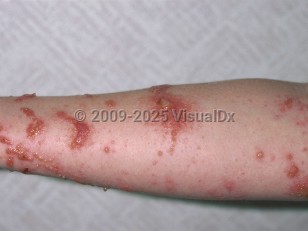Poison ivy, oak, sumac dermatitis in Infant/Neonate
See also in: External and Internal EyeAlerts and Notices
Important News & Links
Synopsis

Poison ivy, poison oak, and poison sumac are the common names for Toxicodendron dermatitis (formerly Rhus dermatitis). This is a contact dermatitis resulting from a type IV hypersensitivity reaction in sensitized individuals to the oleoresin urushiol. Urushiol is found in most parts of the plants from this genus, which is a member of the Anacardiaceae family. The Toxicodendron genus is pervasive throughout the continental United States, southern Canada, and Mexico and is mostly found below 5000 feet of altitude. It can also be found in Asia, Africa, Australia, and New Zealand. It is estimated that up to 75% of the North American population is sensitized and the condition has no predilection based on age, sex, race / ethnicity, or skin type. Occupational and recreational exposures are prevalent.
These species show regional variations in the nature of the plant including growth pattern, leaf characteristics, and flowering.
After exposure to urushiol, the rash begins to appear within 1-2 days in previously sensitized individuals; in the newly sensitized, it may be delayed 2-3 weeks. As the resin is very stable, occult contact may occur from contaminated clothing, gear, or vegetation, even after months have elapsed. In this age group the most common mode of contact is secondary from family members, caregivers, or pets.
These species show regional variations in the nature of the plant including growth pattern, leaf characteristics, and flowering.
After exposure to urushiol, the rash begins to appear within 1-2 days in previously sensitized individuals; in the newly sensitized, it may be delayed 2-3 weeks. As the resin is very stable, occult contact may occur from contaminated clothing, gear, or vegetation, even after months have elapsed. In this age group the most common mode of contact is secondary from family members, caregivers, or pets.
Codes
ICD10CM:
L23.7 – Allergic contact dermatitis due to plants, except food
SNOMEDCT:
200823002 – Allergic dermatitis due to poison ivy
L23.7 – Allergic contact dermatitis due to plants, except food
SNOMEDCT:
200823002 – Allergic dermatitis due to poison ivy
Look For
Subscription Required
Diagnostic Pearls
Subscription Required
Differential Diagnosis & Pitfalls

To perform a comparison, select diagnoses from the classic differential
Subscription Required
Best Tests
Subscription Required
Management Pearls
Subscription Required
Therapy
Subscription Required
References
Subscription Required
Last Reviewed:03/29/2023
Last Updated:04/06/2023
Last Updated:04/06/2023
 Patient Information for Poison ivy, oak, sumac dermatitis in Infant/Neonate
Patient Information for Poison ivy, oak, sumac dermatitis in Infant/Neonate
Premium Feature
VisualDx Patient Handouts
Available in the Elite package
- Improve treatment compliance
- Reduce after-hours questions
- Increase patient engagement and satisfaction
- Written in clear, easy-to-understand language. No confusing jargon.
- Available in English and Spanish
- Print out or email directly to your patient
Upgrade Today

Poison ivy, oak, sumac dermatitis in Infant/Neonate
See also in: External and Internal Eye
